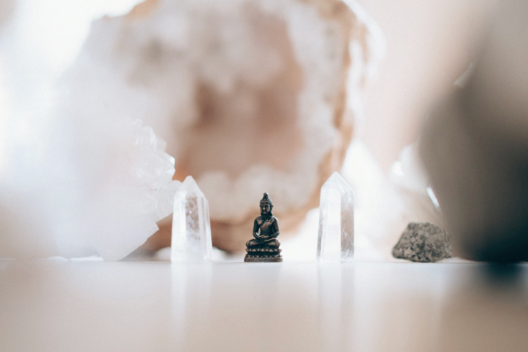Calm Home, Calm Mind: Part 3

CALM HOME, CALM MIND – TOP TIPS FOR LIVING WITH LESS STRESS
We come to you today with our last installment of the Calm Home, Calm Mind series. Today we touch on working form home, movement at home, sleep and self awareness. Wellness is a collection of modalities, and when practiced again and again, our health improves and our lives improve as well. We hope these tips bring you joy, inspiration and little bit more peace of mind.
HOW TO RELAX WHILE WORKING FROM HOME
Working from home might seem like the dream, but once you’ve been doing it for a while, you’ll find it has its pitfalls. Part of reducing your stress at home if you also work from home is knowing how to create a healthy workplace.
Stretch – Most of us unconsciously tense different muscles when we sit in one position for too long, and repeatedly doing this for days at a time can wreak havoc on our bodies. You don’t have to roll out the yoga mat and change into tights mid-workday to make a difference, though! Find stretches that target your chest, hip flexors, and hamstrings. Hold each for 30 seconds and pick one to do each time you fill up for coffee or use the restroom. Just one minute extra a few times a day, and your body will thank you.
Breathe – Taking deep breaths releases tension and brings awareness to where we might be clenching muscles without knowing it. On top of that, it increases oxygen to your brain and helps you to focus and be more alert.
Take Breaks – When you’re working from home, it can be easy to let the day fly right by without taking any breaks. If you find that this happens to you, try setting your phone timer once an hour to remind you to stand up and take a quick break (and maybe a few quick deep breaths and stretch).
Make A Dedicated Workspace – If you haven’t already done this, do yourself a favor and make it a priority. Your workspace is where you spend so much of your time that if it isn’t esthetically calming, you’re not doing your best work or being as healthy as you can. It doesn’t have to be elaborate – invest in some visually pleasing desktop organizers, add a potted plant, candle, and a decorative piece, and your state of mind will thank you!
EXERCISE AND RELAXATION
There’s a reason why you’ve heard your whole life that regular exercise is part of healthy living – it’s true! For many of us, though, exercise is the thing that is the easiest to get out of the habit of doing and the hardest to get back into.
Tips for creating your exercise routine:
Make yourself achievable goals and stretch goals. Whatever that looks like for you set targets that you can achieve and goals you’re working towards. It’s good to challenge yourself, but if you don’t feel a sense of accomplishment because you’re never getting to your target, you’re more likely to give up.
Know that if you miss your goal for the day or the week, that it’s okay. Don’t let yourself throw in the towel, figuratively or literally, because of a bad day.
Be understanding towards yourself. You won’t be at your best or most motivated every day, but even half a workout is better than not moving your body at all.
Types of exercise to suit your life:
-
Yoga – With varying intensity levels, yoga is the perfect way to stretch your body and calm your mind.
-
Tai Chi – Tai Chi is a low-impact Chinese martial art. It helps develop mindfulness and body awareness while being kind to joints and muscles.
-
Qigong Walking – Extolled for its benefits to your body and mind, this type of cardio involves intentional breathing while walking. The intensity can be scaled up as you get stronger.
-
Dancing – Dance your stress away and increase your overall fitness. Dance is a great workout that you can do at home by throwing on your favorite music and seeing where your inspiration leads you or finding a guided class online for more structure.
-
Circuit Training – Get your blood pumping by repeatedly running through a set series of weight and cardio exercises. This is another excellent option for home – there are lots of tutorials and ideas online for ways to set up a circuit that suits your fitness level.
-
Pilates – Like yoga, pilates are focused on body strength and flexibility. There are pilates machines and also many body-weight-only pilates moves.
-
Tennis – If you’re looking for a high-energy form of exercise, you’ll love tennis (‘love’ pun intended).
IMPORTANCE OF SLEEP
Aside from working from home, sleeping is one of the main things we do in our homes. While scientifically, the reason we need to sleep is still a mystery, there are some things we know can improve the quality of our sleep:
Sleep early – This one can be elusive if you’re not naturally an early sleeper. Still, if you can teach your body to go to sleep earlier, you’ll generally be able to sleep for more time, which is beneficial to your overall stress levels.
Manage your sleep – Certain things that we do can harm our ability to get a good night’s rest. Trying to eat a few hours before bed will improve your sleep since your body won’t be busy digesting and will be able to rest. Unplugging and avoiding screens and noise is an excellent habit to get into. If you’re a bedtime TV-watcher, try to keep your screen time outside of your bedroom and find something like a book or a crossword puzzle to do in bed.
Sync with your body’s natural cycle – If you allow your body to catch up and be rested, you’ll find out when it naturally wants to sleep. Of course, it might not be possible to let it dictate your schedule, but knowing what your body naturally prefers when it’s rested can help you balance your sleep cycle if you need to adjust it.
Exercise for sleeping – Moving your body before going to bed can help you unwind and get better sleep; just make sure it’s the right kind of movement. Try to save high-intensity workouts for earlier in the day; it takes your body a few hours to truly come back to rest. If you want to exercise right before bed, many yoga positions won’t elevate your heart rate enough that it’s counterproductive to sleep.
Tips for getting back to sleep – We all know that feeling. You woke up, maybe you tried to hold on to that sleepy feeling, but something kept you awake. All is not lost, though; there are a few things you can try to get back to dreamland. If you’re tossing and turning for more than 10 minutes, take yourself out of bed. Try reading in a comfy chair or walking around your house. If you want, a quick outdoor walk and some deep breathing might help ease you back to sleep
CULTIVATING SELF-AWARENESS
Creating an introspection routine – An introspection routine is a fancy phrase that you check in with yourself for a set time. Often, we are the aspect of our lives that gives way to the pressures of work, friends, and family, and having structure around a self-check helps ensure that your well-being doesn’t get moved to the back burner. Going to therapy is a good way to get to know you better and understand what you need in your introspective routine.
You might notice that you already have a place or time of day that you tend to do this; if so, put more intention around that to ensure you get that routinely. If you don’t, make it a priority to notice how you feel when you do certain activities, what you like, what makes you think, and create time for those things. It’s all about intention.
Create time for yourself – This seems simple but can sometimes be the hardest to put into practice. Our lives can be so fast-paced and the demands on our time so high that creating time for yourself seems like an unreachable luxury. Or, you find that it’s hard to relax when you take that time without thinking about the mountain of things awaiting you. Keep trying. It’s a skill that can be developed and one that will ultimately benefit not just you but those in your life, too.
Get new hobbies – Sometimes, we get stuck in a rut and forget that the world is full of new things to learn, new people, to meet, and new experiences to have. Getting out and doing something new might take you by surprise with how much it revives your mind and spirit. New activities not only help you to relax but also offer you new abilities to overcome self-doubt. Whether it’s an activity you’ve never tried before or something that’s been on your mind for a while, finding a new hobby is like throwing the doors of your mind open to let the fresh air in.
Start by thinking of the place in your home that you spend most of your time. Then choose an area you feel inspired to implement, see how quickly that gets your motivation pumping, and go along from there. It doesn’t have to be perfect after one weekend, just choose a place to start, and soon you’ll be looking back and wondering how you could have lived without your zen garden, wellness space, and overall serene home!
This concludes our three part series Calm Home, Calm Mind. We hope this content proves to be valuable to your home life and beyond. Let us know how it goes!
You might also enjoy:
Calm Home, Calm Mind Part 1
Calm Home, Calm Mind Part 2
Tips for a Great Nights Sleep


